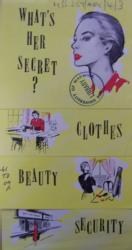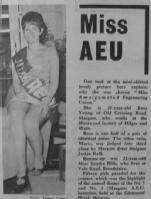How did women engineers seek to reconcile Trade Union issues with traditional views of femininity?
 The main concern in the initial years following women’s inclusion in the A.E.U. was to overturn the perception of women as cheap, makeshift labour. As it became clear by 1950 that there was a permanent female workforce within the engineering industry the focus moved onto how best to increase trade union membership amongst female workers.
The main concern in the initial years following women’s inclusion in the A.E.U. was to overturn the perception of women as cheap, makeshift labour. As it became clear by 1950 that there was a permanent female workforce within the engineering industry the focus moved onto how best to increase trade union membership amongst female workers.
The low membership numbers were a constant concern throughout the 1950s and, in attempts to help recruitment, the monthly Woman’s Angle Newsletter was launched, followed in the late 1960s by the quarterly The Way: For Women and Youth. These publications were therefore not just for women who were already members of the A.E.U. but tried to get more women to sign up.Fashion and beauty features and a jokes section were included in The Way to encourage women who were not interested in trade union issues to read the publications. Whilst reading the fashion and beauty sections it was hoped that they would notice articles promoting the value of trade union membership and the issues with which trade unionism was concerned.
Fashion and beauty features and a jokes section were included in The Way to encourage women who were not interested in trade union issues to read the publications. Whilst reading the fashion and beauty sections it was hoped that they would notice articles promoting the value of trade union membership and the issues with which trade unionism was concerned.
Leaflets such as ‘What’s Her Secret’ showed how trade union membership and values helped preserve the feminine value of beauty. By noting how trade unionism made it possible for a woman to appear as if she did not work in heavy industry, ‘What’s Her Secret’ was directly trying to show how femininity was not compromised by, but actually enhanced, trade union membership.
Repeated efforts were made to demonstrate that a commitment to trade unionism did not necessarily entail losing your feminine beauty. Thus in her 1960 speech to the women’s conference, Mrs McKay drew upon Marilyn Monroe and Elizabeth Taylor as role models of female trade union members. The Margate branch even held a beauty pageant for its female members in 1968, at which 'mini-skirted lovely' Rose Young was voted the winner.
There was opposition raised to the publications’ inclusion of fashion tips and glamorous models, as at the 1956 conference when some members felt the Women’s Angle Newsletter should focus solely on trade union issues. Yet it must be remembered that these publications were in no small part recruitment propaganda and therefore to associate trade unionism with glamour and fashion was no doubt a very sensible move in widening the appeal of trade unionism.
